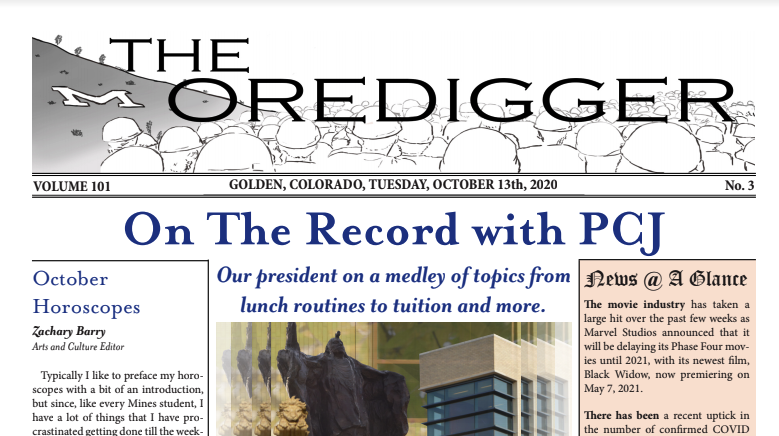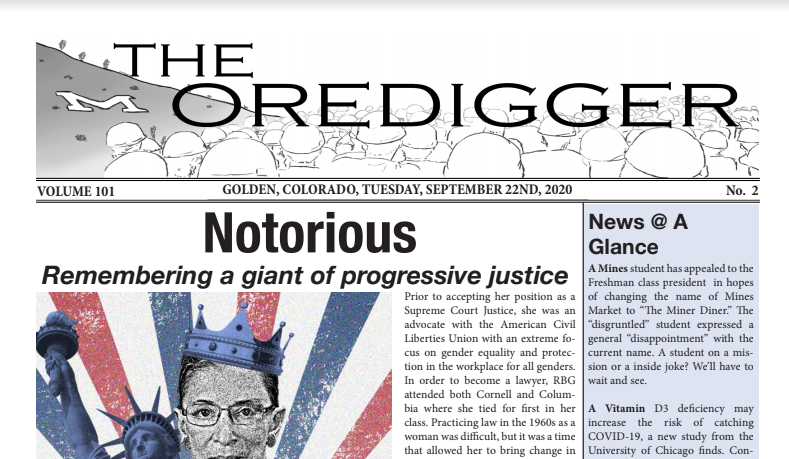Ian Stone closed out the High Grade release party April 18 by thanking the attendees for supporting the arts at Mines. “It’s an engineering school. We need a little bit of balance sometimes…or all the time.” Out of the many brilliant scientists and artists at Mines, arguably no one exemplifies balance better than Stone, who is a multifaceted artist between writing MATLAB functions in the Geophysics undergraduate computer lab, finishing up his degree this semester.
Although renowned for engineering, Colorado School of Mines seems to excel at more than just numbers, as evidenced by the release of the 2014 edition of High Grade, the CSM journal of the arts, this April. For decades, High Grade has been an outlet for Mines’ hidden artists, and has only grown since then. As a STEM-focused school, it is no surprise that CSM’s High Grade is incorporating technology more with their exclusive content found on highgrade.mines.edu which includes longer short stories and music from multiple artists.
High Grade is now available throughout campus, but Stone tells of High Grade going bigger.
[Oredigger]: How and when did you get involved with High Grade?
[Stone]: I started working with High Grade in my sophomore year, first as a staff member and then as the art editor in my junior year. I had seen the amazing art in previous editions and knew that working with the journal would be a great way to contribute to the art scene here on campus.
How has High Grade changed or grown over the years?
High Grade has changed significantly over the years. When the journal was founded in 1976, it was more of a pamphlet than a journal. It was only a few pages long, all black and white, and was hand stapled. For many years the journal continued in this manner until the current faculty advisor, Toni Lefton, took over about a decade ago and helped the editors and staff turn High Grade into a professionally bound, significantly longer publication. In the past few years, we have added a music section, increased the dimensions of the publication, and changed the format such that art, poetry, fiction, and creative nonfiction pieces are distributed throughout the book, rather than confined to specific sections. As a result of these changes, High Grade is on par with the extent and quality of similar journals put out by the liberal arts programs of large, world renowned institutions. As a matter of fact, High Grade was awarded the “Best Use of Technology” award at the 2012 ArtIST conference for our music CD. That’s why I think the recent changes to the journal have been for the better.
Big picture-wise, how do you see High Grade growing in the future?
Perhaps the next big step for the journal will be broader distribution. The incoming editor in chief, Cristina Ochoa, plans on taking High Grade to the 2015 Association of Writers and Writing Programs (AWP) Conference. The AWP conference has the largest book fair of any literary conference in the US, and distributing High Grade there will demonstrate on a national level how multifaceted and creative Mines engineers are. The conference also provides an opportunity to meet and exchange ideas with the editors and staff from similar publications, so the possibilities for future improvement are virtually endless.
What is the most difficult part of being editor in chief of High Grade?
The most difficult part of being editor in chief is just keeping on a tight schedule, which I guess is part of being responsible for any large campus organization. There’s always a deadline around the corner, be it a jury session, a layout date, or a publication deadline, and you have to constantly be on your toes to keep up with everything. This year has also shown me the importance of delegation; putting together the journal would not have been possible without the input and help of my staff and editors, and I really cannot thank them enough for all their hard work. That leads into the second hardest part of the job: having to choose what goes into the journal. I am consistently blown away by the quality and volume of art we receive from our campus community, and choosing just a few pieces from that selection is a daunting task. We only tend to publish around 10% of the several hundred pieces we receive, so it’s extremely important that we set an aesthetic for the journal prior to going into the selection process. Even with an aesthetic, our jury sessions, which are run by our editors and staff, can last hours at a time and have even taken several days in the past. This is probably the most important part of putting the journal together, however, so my staff is willing to put in the hours to make sure the selections will combine to make a great publication.
What has been your favorite part of being Editor in Chief this year?
My favorite part of being editor in chief is getting to see all the amazing artwork done by my peers and working with my staff to create a showcase for it all. And of course, nothing beats being able to hold a copy of the journal in hand, knowing all the work that went into on behalf of my staff, and of course, the artists whose amazing work is inside.
What makes this issue special or stand out from the previous versions?
This year, our music section went completely digital. Rather than having a CD, our music is all available to be downloaded and streamed at highgrade.mines.edu. This way, you can access the music even if you don’t have a copy of the journal on hand. We also have loads of exclusive content on the website, so you should definitely check it out.
Is it surprising getting to see how artsy Mines students truly are?
Yes and no. I am not surprised by the artsiness itself; after all, engineering and art are just two different types of creation. It is surprising, however, to know that there are so many artists here on campus that aren’t more vocal about their hobbies and passions. I’ve come to find that the “strictly-engineering” climate here on campus, as well as the lack of studio arts courses, turns people away from art and squelches conversations about its importance as a means of personal expression, which I think is a shame. Creating and admiring art are cathartic, and too few people on this campus appreciate that.
Has art made you a better scientist?
Creating and appreciating art often requires us to think in terms of abstractions and garners unique problem solving skills. That has definitely helped me as a scientist. Additionally, developing a skill that allows you to articulate your emotions makes you more empathetic and increases your emotional awareness, which I feel has made me a more responsible engineer.
Has science made you a better artist?
Well, Photoshop makes much more sense now that I’ve taken Digital Signal Analysis. Being a scientist allows you to appreciate the inner workings of the world around you, and once you understand the beauty and complexity of some facet of reality, it inevitably finds its way into your artwork.



'“Engineering and art just two different types of creation”' has no comments
Be the first to comment this post!